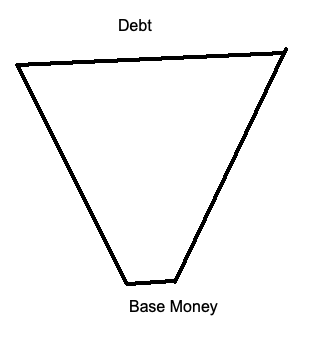The Fed is stuck. We’ve heard it before. But what does that mean exactly and how do we know?
The Fed has widely announced a new monetary tightening cycle. We hear from Jerome Powell himself that rates will go up and QT is just around the corner. This last bit scared investors; QT means actively reducing the amount of cash in existence. The actual meaning of “what is a US dollar” is determined by the Fed and its policies. The Fed is telling us that Dollars will be much scarcer and stronger. Thus asset prices are falling and relative strength is flowing to those assets which deliver Dollars sooner.
The Fed is on a knife’s edge. If it goes one way, we get heightened inflation and the accompanying ills to society. If it goes the other way, we shall likely have a massive crash, even a new Depression. This is not hyperbolic. The sensitivity of asset prices to monetary policy is proportional to the total amount of debt. With so much debt in the system, we’re not likely to see a gentle outcome.
Consider the solvency of banks. They own long-dated debts. They have short-term obligations to depositors and other creditors, like the repo market. Now consider this simple trapezoid below. A large swathe of debt relies on a narrow base of money held in reserve. They are not equal because of financial rehypothecation. If that base is eroded, then the debt rests upon a narrower and weaker foundation. Through quantitative tightening, the Fed directly reduces the supply of cash in the system and undermines that foundation.
As the supply of base money diminishes, in theory the quantity of debt should diminish to maintain the same ratio. In practice this amounts to deleveraging and austerity. The economy must cease the net expansion of debt and instead pay them off. This is extremely painful. In today’s economy, it is tantamount to Depression.
QT was tried in 2018. The draining of cash led to a spike in repo markets to unheard of interest rates. This is how the problem of too little base money for too much debt first manifested itself. The Fed responded by printing money in a new round of QE in 2019 that went largely unnoticed. It was necessary because, ultimately, there was too much debt for the amount of extant cash. The base needed to be widened. Where are we today? Debt has grown massively; we need a correspondingly larger base of cash to maintain stability. Thus while QT may be attempted again, the required amount of cash in the system is greater than before. We have therefore a cycle of easing and tightening that ratchets consistently upwards. We can never reach the balance sheet and interest rates we had before because we cannot extirpate debt. As a society, we do not tolerate prolonged austerity. Thus the debts must always go upwards. And to prevent a crash and disruption of credit markets, then the amount of base money must also go up.
All this means that the current trajectory of tightening has limits. Because of the heightened debt levels since 2018, the limits of tightening are lower than they were before. Perhaps about half the rates we had in 2019, aka 1-1.5%?
Some may say that the Fed will tighten regardless of what happens in financial markets or the economy. This is very unlikely. Where is the political constituency in favor of a Depression? Which political party is ok with mass insolvency? With mass foreclosures? These people simply don’t exist. It is easy to talk tough about tightening when the consequences of those policies have not yet manifested themselves. Inflation seems like the greater evil now that we don’t have to face an actual downturn (yet). But when the downturn comes, inflation will seem like a lesser evil than mass unemployment, credit failures, and bankruptcies.
The powers at be in our society greatly favor inflation to deflation because they are direct beneficiaries. The government itself is massively indebted and prefers that that debt be debased away. To expect inflation is to expect the government to pursue its own interests: a safe bet indeed. The most powerful and influential people in this country are not on fixed income. They are not holding cash. They hold financial assets and are in debt, either personally or transitively via the entities they own. Their self-interest can only push in one direction.
And we should not forget the Federal Government’s financial situation. The total debt figure just hit $30 trillion. This puts our federal debt/gdp ratio at 1.25. Every 1% of interest rate hikes represents an additional $300 billion in yearly interest payments that must be made. And since the duration of US debt skews lower, we adjust to this yearly interest figure rapidly. Unlike during the Volcker era, where strictness was mathematically feasible, today it is not. The government will buckle under that interest burden, to say nothing of corporations, municipalities, emerging markets, or over levered home buyers.
So I do not believe we should take at face value the hawkish statements from the Fed. Similar things were said in 2018. Yet those people blinked and quite early. There is no constituency advocating for higher rates and austerity. Barring a massive increase in taxes or a huge decrease in spending, the federal government’s budget requires monetary debasement to maintain the illusion of solvency.
All of the above doesn’t mean that morally we shouldn’t normalize monetary conditions. We should. Inflation will be incredibly damaging to the fabric of our society. It is better to acknowledge past mistakes honestly by allowing things to crash than to lie to ourselves by printing money. Yet while I believe this morally, I am not betting on it with my portfolio. Merely to expound the idea is enough to illustrate why it will not happen.
Instead the inexorable debasement of the Dollar will add to societal stress and upheaval. We have only to look at other countries, past and present, to see the injury and tumult that will derive from inflation. Let us just hope it does not end in war or revolution, as it typically does.





i also think is just fanfare the announcement or rate hike, we will see, also inflation can be in a sense controlled if you are able to rebase the money on the user side, and this would be feasible with a cbdc, in a sense inflation would be a great enabler of that giving great incentive to ppl to connect to the system with a "social credit system id", in a sense what they fail to impose with the virus story ("green pass"), they will probably succeed to do with inflation, they will have direct access to money of the individual and they will be either able to raise or to decrease the number in your account probably, at least this makes a lot of sense since definitely the situation isnt controllable with the old means
in a sense this "crisis" was already an attempt to manage inflation not from the top down (qe or rates) but from the user side (close ppl at home and make illegal to spend)
these is already proposal in this sense here https://vanderbiltlawreview.org/lawreview/2021/10/the-peoples-ledger-how-to-democratize-money-and-finance-the-economy/ (that is commented here https://youtu.be/5DEYl3ryop0)